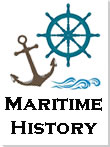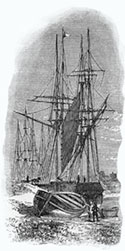Maritime History of Newport
By Peter Brown
© Peter Brown 2024
The later Middle Ages
The Town Pill in Newport was an inlet from the river that once reached along Skinner Street into the town centre. It was located immediately north of where the Riverfront Theatre stands today. In the Middle Ages it was used as a safe harbour for ships, but it is now filled in. In 1934, excavations revealed fragments of what appeared to be a barge, together with pottery and tiles from Bristol dated to the 13th or 14th centuries. These demonstrate the trading connections with Bristol at that early date.[1]
For the first time, the 14th century provides us with some records of maritime trade with South Wales, and a document of 1303 in The National Archives records customs collected by John Wynter and Thomas Bolepenne, who were “collectors of New Custom” at Carmarthen.[2] John and Thomas “rendered account for 58 shillings received from Arnold Gecye, merchant, of Gascony, for the customs aforesaid for 29 hogsheads of wine loaded in the ship called la Nicholas de Insula.” The customs were “beyond the ancient customs collected and received from the foreign merchants and aliens at Kermeryn (Carmarthen).” The ship arrived in Carmarthen and was also carrying hides. This entry is our first evidence of the trade and customs that Newport engaged in over the following centuries. The document also refers to collectors of New Custom at Bristol.
A post-mortem inquisition on the death of Earl Gilbert’s son in 1314 describes Newport as “a market town” (villa mercatoria) with an annual value of £34 16s. 2d. The 275 burgages generated annual rents of £13. 15s.2d.[3] Newport became the administrative centre of an independent Marcher lordship three years later, valued at £48 7s. 10¼d. per annum.[4]
In 1324 Edward II granted a charter that included Newport on the King’s Customs,[5] and Hugh Despenser secured for his burgesses and tenants release from all tolls, murage, pontage, picage, pavage, quayage, terrage, lastage, tronage and other customary dues levied on traders or their merchandise in royal boroughs in any lands ruled by Edward II. These privileges were confirmed in 1324,1359, 1394, 1423, 1465 and 1497.[6] In 1348, an old Tollbooth or Custom House was built at the Westgate.[7]
Confirmation of the status of Newport as a borough came in 1385 from Hugh, Earl of Stafford, and was confirmed by his successor Humphrey in 1427. The 1385 Charter is lost, but confirmation of it survives in a 1427 version. Burgesses and their successors were released from commercial tolls and exactions, and the burgesses were authorised to form a guild with a monopoly of commercial activity within the borough.[8]
The new borough’s expansion soon grew beyond the protective walls and began to form a linear settlement along the road between the castle and Stow Hill. Extra burgage plots were laid out, and the town became the single trading community of the lordship. Additionally, licenses were sold to allow strangers to trade in the town, and an annual 15-day fair was created when strangers were allowed to trade freely in the castle bailey. Despite this, the castle remained vital to the settlement, forming the administrative hub containing the exchequer and treasury.[9] The castle was situated to the immediate north of the town bridge and is mentioned in the 1358 town charter.[10] The castle's central tower still contains an impressive watergate, or vaulted dock, which opens directly onto the river and would have allowed access to a sizable vessel. The Earls of Stafford built this tower and dock in the late 14th century.[11]
Later in the 14th century, the Austin Friars was founded in Newport by Hugh, second Earl of Stafford, in 1377.[12] Ten years later, Newport was the focus of a Royal Commission to discover if English merchants were landing their ships and unloading goods where the King’s customs could be evaded.[13] We also know that in 1394, during the visit of Richard II to Newport, William Hawker, master of the ship "La Maudelyn", was given the right to impress mariners to crew his ship in Newport.[14]
The 1401-2 account of Roger Thomas, reeve (administrative officer for the Lord) of the borough, reveals that five fair courts and 22 sessions of the hundred court (covering a larger area than the manor) were held during the year. These accounts show Newport as a busy market town of considerable value to its lord.[15] However, the economies of the town and Caerleon were said to have been devastated by the attack of Owain Glyndwr in 1402.[16] An inquisition post-mortem on the death of Edmund Stafford in the following year “returned that the borough of Newport, indeed the entire lordship, was worth nothing to its lord.” The effects of the attack were not short-lived, as can be seen by the account of the mayor, William Berne, in 1434-5, who lists “sixty one tenures decayed because of the Glyndwr turbulence.”[17] However, the accuracy of these reports has been questioned,[18] and the recent discovery of a large ship of mid-15th century date to the south of the Town Pill suggests that the town had experienced something of an economic revival or that the reports of the town’s poverty were somewhat exaggerated.[19]
We know that in 1405, a longtrowe (flat cargo boat) was hired to carry timber, and another longtrowe laden with burnt lime was bought at Bristol for work on the Great Tower of Newport Castle.[20] The castle was remodelled between 1436 and 1447 by Humphrey Stafford, First Duke of Buckingham.[21] In 1447, stone for use at Newport Castle was carted to Bristol and sawn into pieces for transport by boat to Newport. Also, sea coal was brought from Hanham, just east of Bristol, for burning lime for the castle, and 18 boatloads of “stone called Lyas” were shipped from Penarth.[22] These details indicate that the river Usk was a vital transport route for supplying the castle, presumably for people and goods.
In 1402, Henry IV introduced a law that all ships laden with goods entering the realm must use “great ports”, not creeks or small rivers.[23] This Act of Parliament gave the Crown the power to control all sea traffic for customs purposes with the threat of forfeiture of the goods for noncompliance. The only exception was for extreme emergencies such as storms, meaning that traditional landing places in creeks and small rivers became the domain of smugglers.[24] This elevated “Bristowe” to the “great port” for all the English coast from Bridgwater to the boundary of Wales. The ports of Newport and Caerleon came under the “great port” of Cardiff, to which all their trade was credited. It was not until 1823 that Newport finally became an independent port free of Cardiff.[25]
Two unusual incidents revealed some issues connected with Bristol Channel shipping and the dangers due to the Severn Bore, extensive sandbanks and grounds, and occasional rocks in the Channel, particularly to the north of the mouths of the Usk and the Avon.[26] A ship returning from Gascony in 1331 was driven onto Goldcliff beach, scattering its cargo on both sides of the Channel. The crew managed to reach safety in Portishead and Clevedon, while 45 inhabitants of Goldcliff, Nash and others from the other side of the Channel made off with the merchandise.[27]
In 1394, John Banberye (Banbury) of Bristol petitioned Parliament regarding the loss of his ship and its cargo.[28] In January of that year, the ship was “returning to Bristol from Gascony with wines and other merchandises but ran aground on a sandbank in the Severn.” The location is not given, but this was somewhere between Newport and Chepstow, probably near Goldcliff.[29] When Banberye and his men went to try to save the ship and its contents, “they were prevented from doing so by people from Newport, Caerleon, Magor, The Pill, Nash, Pwllmeyric, Chepstow, Beachley, and other towns in Wales, who broke the ship up with hatchets and other instruments and stole its contents and equipment.” The outcome of this petition is not recorded.
Trade and shipping
Between 1397 and 1400, John Banham, a burgess of Newport, shipped wool through the Carmarthen staple (in a ship not named), where they could be legitimately traded with foreigners.[30]
The town also began to develop as a port, with much of the trade centred around the large inlet known as the Town Pill. This provided merchants with an excellent, safe harbour and easy access to the town. The Medieval economy of Newport appears to have been based around trade, such as importing coal for ironworking and exporting fleeces and processed cloth.[31] Evidence for using the Town Pill area can be seen in the discovery of the Newport Ship and the presence of the Medieval quay. The early layout of Newport is a fine example of a ‘planned’ settlement, with the burgages dovetailing with the existing field system of Stow Manor. The growth of the town was steady at that time.[32]
The Swan had its home port at Newport from 1436-41,[33] and a Royal Commission was designated to hire a ship from Newport, “le Swan”, for the King’s navy.
A carvel boat (with hull planks that don’t overlap) was built in Newport around 1454 for Morgan ap Jenkyn ap Philip and William Keynes, requiring a shipwright to be brought over from Bristol. They were income receivers for the lordship, so the ship was probably commissioned by their master, the Duke of Buckingham.[34] This ship may have been the Trinity of Newport, John Lloyd master, which received a safe conduct for trading overseas in 1460. In 1461, the Trinity of Newport, master John “Thloyd”, took woollen broadcloth from Bristol to Ireland. In May 1462, the Trinity of Newport, of 400 tons burden, was granted a licence by Edward IV to carry 300 pilgrims from Bristol to St. James of Compostela in Spain. No other ships of this size are known in South Wales at this time.[35]
The Minister Accounts for Newport for 1464-1465 indicate that the Lordship received revenues from traffic "under and over the bridge" and to the passage of vessels "beyond the water" before the making of the bridge. Between 1465 and 1468, during his receivership of Newport, William, Lord Herbert made a net annual profit of about £358, above the annual farm of £100 a year that he was paying into the Exchequer.[36]
In 1480, the Christopher of Newport brought fish and hides from Ireland to Bristol, with Morris Hagharn as master. Richard ap Meric, John Parkyns, Walter Lincoln, William Kemes, John ap Prine, and John Develyn were the shippers.[37]
Ships
It is likely that most shipping at the time was local and involved small craft that generated little by way of documentary evidence. In the 14th century, the cog was still the standard vessel used for longer-distance trading, and it was a time of experimentation with cog design where they grew bigger and the size of the castles was enlarged. In the 13th century, cogs were rarely over 100 tons, but by the early 14th century, most were over 100 tons, and some were as large as 300 tons.[38] These records relate mainly to the Gascon wine trade, which reached its height in the early 14th century. In 1308-9, more than 102,000 tons of Gascon wine left for northern ports, and while we don’t know all the locations, we know that Gascon wine was being imported into Newport in the 16th century.
Around 1400, experimental ship design began to add a second mast on both small and large vessels, and these were overtaken by three-masted vessels soon afterwards.[39] In northern Europe, the cogs that had dominated the sea-going trade for about 200 years were overtaken by carracks, developed in the later Middle Ages as a progression from the earlier single-masted cogs. In its most developed form, the carrack was a carvel-built ocean-going ship: large enough to be stable in heavy seas and spacious enough to carry a large cargo and the provisions needed for long voyages. They were three- or four-masted ocean-going sailing ships, which changed the nature of shipping.
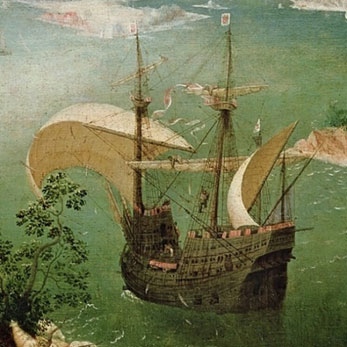
A carrack by Pieter Bruegel the Elder, c1558.
Image from Wikipedia article on “Carrack”, reproduced under Creative Commons licence.
Carracks were a critical stage in ship development that enabled the long voyages of exploration to the Indian Ocean and later the Americas, which began in the 15th century and continued beyond. To put this into context, Columbus’s flagship in 1492 – the Santa Maria – was probably a carrack, recorded as a little over 100 tons. The first ship to circumnavigate the globe was another carrack called the Victoria, which was the only ship of Magellan’s fleet to return to Spain in 1522. The Victoria was an 85-ton ship with a crew of 42. It was not until 1580 that a second ship circumnavigated, and that was Sir Francis Drake’s galleon, the Golden Hind.
The later carracks were square-rigged on the foremast and mainmast and lateen-rigged on the mizzenmast. They had a high rounded stern, with aftcastle, forecastle and bowsprit at the stem.[40] Galleons superseded them in the 17th century after many years of good service.
The Newport ship
In 2002, during the construction of the Riverfront Theatre, the best-preserved late Medieval ship ever found was discovered in Newport. Only a summary is included here, as this has been studied and published in detail elsewhere.
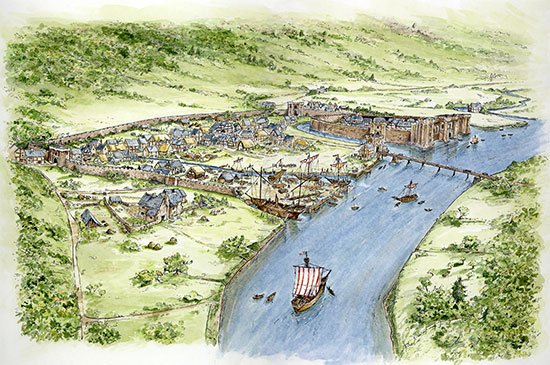 Anne Leaver drew this theoretical view of Medieval Newport with the guidance of Bob Trett.
Anne Leaver drew this theoretical view of Medieval Newport with the guidance of Bob Trett.
This shows the Town Pill reaching into the town and harbouring ships. The Newport Ship is shown in an inlet just south of the Town Pill, near where the Riverfront Theatre stands today.
Copyright Anne Leaver
A silver coin embedded in the keel provided a construction date after 1447, and recent dating suggests 1457-8 as the time the timber was felled.[41] The evidence indicates that the ship was moved to an inlet for repairs in the late 1460s, but the supports failed, and the ship fell over into the mud. It was eventually stripped and abandoned around 1470 despite efforts to recover it.[42] The ship had a substantial oak frame, with overlapping oak planks (clinker) joined by wrought iron nails. The likely construction place was the Basque country in northern Spain or southern France. The ship has been interpreted as a large merchant vessel of around 161 tons, with two complete decks, a bow and stern castle, and three masts.
The surviving contents of the ship included coins, shoes, textiles, pottery, wooden objects and other items identified as the crew's or passengers' personal effects. The presence of stone shot for a wrought iron gun, an archer’s wrist guard, and fragments of a helmet reveal that the ship was equipped to deal with conflict at sea. Other finds suggest trade with Portugal. The evidence indicates that no one in Newport owned the ship but that perhaps it was acquired by either William Herbert, Earl of Pembroke, or Richard Neville, Earl of Warwick, who took over the Newport lordship following Herbert’s death in July 1469. Newport might have been the logical place to lay up the ship for repairs, but in the event it never sailed again.[43]
In 1469, an instruction from Richard Neville, Earl of Warwick, authorised reimbursements for the “making of the ship at Newport”, probably meaning renovation work.[44] Iron was brought from Cardiff for the said ship, and Matthew Jubbez was paid “in money, yron (iron), salt and other stuffe belonging to the seid ship. £15 2s. 6d.” This suggests that its previous voyage had been to Biscay, a major Basque iron and Bay salt supplier.
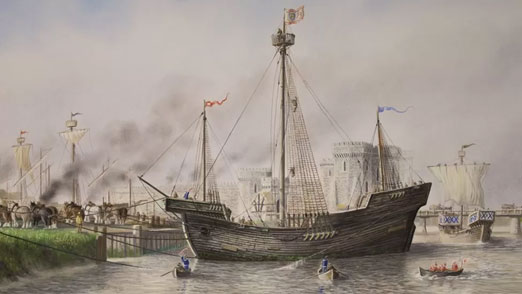
This is how historians think the Newport ship may have looked as it docked in South Wales in the 15th Century.
Copyright David Jordan
References
1 Jones, Evan T. and Stone, Richard (2018) The World of the Newport Medieval Ship: Trade, Politics and Shipping in the Mid-Fifteenth Century, 83.
2 Dawson, J. W. (1932) Commerce and Customs: A History of the Ports of Newport and Caerleon, 2; TNA E 122/15/1.
3 Howell, J. K. and Dunning, R. (2004) Urban Waterfronts in southeast Wales: Phase 1, Desk-based assessment, GGAT report no. 2004/075.
Online at: http://www.ggat.org.uk/cadw/cadw_reports/waterfront.html , citing Griffiths, R. A. (1978) Boroughs of Mediaeval Wales, 196-98.
4 Griffiths, 200.
5 Dawson, 2-3.
6 Griffiths, 208.
7 Dawson, 3.
8 Rees, William (1951) The Charters of the Borough of Newport in Gwynllwg, 9; Griffiths, 208.
9 Howell and Dunning, 21.
10 Soulsby, Ian (1983) The Towns of Medieval Wales, 203.
11 Howell and Dunning, 21, citing Knight, J. K. (1991) ‘Newport Castle’, Monmouthshire Antiquary, 7, 17-42.
12 Trett, Bob (2010a) Austin Friars.
Online at: http://www.newportpast.com/early/friary/index.htm
13 Griffiths, 213, citing CPR 1385-9, 282, 320.
14 Trett, Bob (2007) Newport Ships and Shipping in the late Middle Ages: A Chronology.
Online at: http://www.newportpast.com/early/port/dates.htm , citing CPR (1391-6) p.522. 6th September 1394.
15 Griffiths, 203.
16 Rippon, S. (1996) The Gwent Levels: The Evolution of a Wetland Landscape, Monograph published 2002 via Archaeology Data Service, Council for British Archaeology Research Reports, 105, 97.
Online at: https://archaeologydataservice.ac.uk/library/browse/issue.xhtml?recordId=1075302 ; citing Bradney, J. A. (1904) A history of Monmouthshire, 25; and Owen, D. H. (1989) Settlement and Society in Wales, 210-11.
17 Howell and Dunning, 22, citing Griffiths, 204.
18 Maylan C. N. (1991) Proposed Usk Barrage Initial Archaeological Assessment, GGAT Report No. 91/01
Online at: https://walesher1974.org/her/app/php/herumd.php?level=2&group=GGAT&docid=301464088&linktable=her_source1_link
19 Howell and Dunning, 21-2.
20 Trett, 2007.
21 Knight, 25, 34-35.
22 Trett, 2007.
23 Dawson, 3.
24 Customs Act 1402, 4 Hen.4 c.20, Customers, “Controllers etc shall abide upon their Office, and make
no Deputies: and every Customer shall be sworn to answer the King all Profits”; cited in Walsh, Tom, (2021) ‘The Establishment and Application of the DNA of Customs Law and Practice’, World Customs Journal, September 2021, Volume 15, Number 2a, 3-22.
Online at: https://worldcustomsjournal.org/Archives/Volume%2015%2C%20Number%202%20(Sep%202021)/1922%20000%20WCJ%20v15n2%20COMPLETE.pdf#page=10
25 Dawson, 62.
26 Jones and Stone, 99.
27 Jones and Stone, 99.
28 TNA SC 8/96/4758. CPR 1391-6 p.433 is dated 14 March 1394 and seems to be in response to this petition.
29 Jones and Stone, 99-101.
30 Trett 2007; Jones and Stone, 83
31 Griffiths, 1978.
32 Howell and Dunning, 21-2.
33 Jones and Stone, 83; CPR (1436-41) p.411, cited in Trett 2007.
34 Jones and Stone, 84.
35 Jones and Stone, 84.
36 Trett, Bob (2007b) The Newport Medieval Ship.
Online at: http://www.newportpast.com/early/port/ship.htm
37 Trett, 2007; Jones and Stone, 84.
38 Unger, R. W. (1980) The ship in the medieval economy, 600-1600, 163.
Online at: https://archive.org/details/shipinmedievalec0000unge
39 Unger, 217.
40 https://en.wikipedia.org/wiki/Carrack
41 https://www.bbc.co.uk/news/uk-wales-67302907
42 Jones and Stone, chapter 2.
43 Jones and Stone, 88.
44 Jones and Stone, 84-5.
Back to Index of Peter Brown's "Maritime History of Newport "
